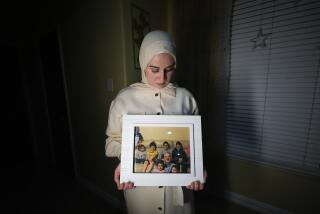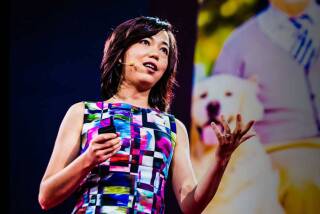China sheds little light on detained activist Ai Weiwei
- Share via
Reporting from Beijing — Was it the semi-nude photographs of himself he posted on the Internet? Was it the current exhibit at London’s Tate Modern in which he uses millions of sunflower seeds to make a playful commentary about how the Communist Party treated the late Chairman Mao Tse-tung as the sun, his subjects as sunflowers fawning toward the light?
Or maybe the Twitter postings he’d make on the birthdays of the more than 5,000 children killed in the 2008 Sichuan earthquake, commemorations that served to remind the public that shoddy school construction led to so many deaths among the young? Or the blog in which he rambled on about modernism, animal rights, historic preservation and freedom of speech?
The list goes on. No doubt the artist Ai Weiwei did plenty get in the face of the Chinese authorities. But why he was seized April 3 at Beijing International Airport as he passed through immigration to board a flight to Hong Kong is anybody’s guess.
Chinese authorities have refused to say, and have failed to notify his family of his whereabouts or disclose the charges against him, despite a law requiring they do so within 24 hours.
Reports in the official press suggest they’re still trying to come up with the charges to justify his seizure, with pornography, tax evasion, plagiarism, bigamy and failure to obtain travel permits all mentioned as possibilities.
“It is a mystery. They haven’t notified us of anything. They shouldn’t be doing this. He really is just an artist trying to express his individuality through his art,” his mother, Gao Ying, said in a telephone interview.
But for Ai, art and activism came to be indistinguishable, putting him in frequent conflict with the powers that be.
The 53-year-old Ai defies easy definition. He is at once an architect, photographer, blogger and activist (he shuns the word “dissident”) whose presence in Beijing is disproportionate to his (considerable) standing in the art world.
He has 70,000 followers on Twitter. He designed many of the studios in Caochangdi, a Beijing district he dubbed the East Village that is increasingly supplanting the more commercialized 798 warehouse district as the hub of the contemporary art scene. His own brick-walled studio functioned as an open house for intellectuals and activists, not to mention dozens of stray cats.
And the fact that he remained free served to embolden a younger generation of artists, writers and activists.
“We saw the freedom he enjoyed and figured if we imitate what he does, we can get away with expressing ourselves without getting in trouble,” said Su Yutong, a 30-year-old activist now living in Berlin who worked with Ai on the Sichuan earthquake project.
Until recent months, Ai seemed to enjoy a Teflon-like immunity. His critical success abroad made him something of a national treasure. His work as an architectural consultant on the Bird’s Nest stadium for the 2008 Beijing Olympics allowed him to teeter on the edge of the mainstream, although he later came to deplore the Olympics as a joyless monument to authoritarianism.
His lineage also conferred privilege: His father, Ai Qing, despite years in exile during the Cultural Revolution, is revered today as one of China’s most influential poets.
Ai’s early works were more provocative than subversive. He painted Han dynasty vases with Coca-Cola logos and then broke them. His wife, Lu Qing, posed a la Marilyn Monroe, lifting a billowing skirt in front of Mao’s portrait at Tiananmen Square.
His activism was confined to relatively noncontroversial causes; he joined a group of animal rights activists in 2007 in a commando-style raid to rescue hundreds of cats headed to southern China, where cat meat is a delicacy.
But friends say the 2008 earthquake changed him. Ai, outraged by the arrests of bereaved parents protesting low-quality school construction, felt obliged to use his prestige to speak up for those without a voice.
“He got more serious about the content of his message after the earthquake,” said Lee Ambrozy, a translator who this month published the first major English-language collection of Ai’s writings, “Ai Weiwei’s Blog: Writings, Interviews, and Digital Rants, 2006-2009.” “With the Internet, he was reaching out not so much to the art worlds as an audience of disinterested and disaffected youth in the provinces.”
Ai traveled to Sichuan in 2009 to attend the trial of an activist, Tan Zuoren, who was investigating the earthquake. Police burst into his hotel room at 3 a.m., and in a scuffle, he suffered bleeding on the brain, requiring lifesaving surgery four weeks later.
At that point, his art and activism merged.
At Munich’s Haus der Kunst gallery, Ai displayed children’s backpacks that spelled out in Chinese a quote from one of the mothers: “She lived happily on this Earth for seven years.”
He took a series of photographs of himself nude holding a toy horse that covered his genitals, a profane visual pun that played on the similarity between the words in Chinese “Party Central Committee” and “Cover the Center” and between “horse” and “mother” to suggest what he thought the party should, ahem, do.
His confrontations with authorities increased. In December, he was blocked at the Beijing airport from leaving the country, apparently out of fear that he might attend the Nobel Peace Prize ceremony for imprisoned writer Liu Xiaobo. In January, his studio in Shanghai was demolished.
“He always talked about how he expected to be arrested. I wonder if he didn’t get tired waiting for this day to come, or wonder why it came so late,” said Yang Licai, a 30-year-old designer who also worked with Ai on the earthquake project.
Ai is only one of dozens of activists and intellectuals to be arrested this year — 59, by the count of Hong Kong-based human rights advocates — but it is his case that is galvanizing international outrage. Demonstrations were staged Sunday in front of Chinese consulates and embassies across the world. The Tate has written in prominent black letters along its facade, “Release Ai Weiwei.”
In Beijing, Ai’s disappearance has cast a pall over the intellectual and cultural scene.
“Ai Weiwei really lit a spark for the younger generation,” Su said. “The question now is whether because of his arrest that spark will be extinguished, or will it ignite a larger fire?”
More to Read
Sign up for Essential California
The most important California stories and recommendations in your inbox every morning.
You may occasionally receive promotional content from the Los Angeles Times.













